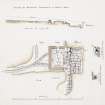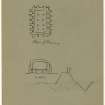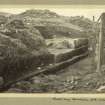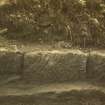Scheduled Maintenance
Please be advised that this website will undergo scheduled maintenance on the following dates: •
Tuesday 3rd December 11:00-15:00
During these times, some services may be temporarily unavailable. We apologise for any inconvenience this may cause.
Excavation
Date 1902
Event ID 571421
Category Recording
Type Excavation
Permalink http://canmore.org.uk/event/571421
The Roman fort at Castlecary occupies a rounded knoll at the W end of a low ridge, and is protected by the valley of the Bonny Water on the N, the ravine of the Red Burn on the W, also by a tract of low-lying land, which was formerly marshy, along nearly the whole of the S front. Periodically raided for building materials from at least as early as the 15th century, the fort was mutilated in 1841 when the line of the Edinburgh and Glasgow railway was carried diagonally across it, and further damage was no doubt done when the modern road was laid along the N front. At the present time the portion of the site that lies to the N of the railway is in permanent pasture, while the portion S of the railway is cultivated.
Excavations in 1902 (D Christison 1903), showed that the fort was oblong on plan and enclosed an area of 3 1/2 acres, the internal dimensions being 455ft from N to S by 350ft transversely.
The main defence consisted of a stone wall which was carried round all four sides of the fort, the Rampart of the Antonine Wall abutting the NW and NE corners. The fort wall was built of stones quarried from the outcrop of rock immediately to the W of the site: it was 6ft 6ins thick and was set on a massive foundation-course which in turn rested on a bottoming of clay and cobbles. The N wall, however, differed from the others in that it was thickened at either end to bring it more nearly into conformity with the thickness of the Antonine Rampart, while it may have had a rampart bank against the inner face.
The Ditch of the Antonine Wall formed the outer defence of the fort on the N side, although to the W of the causeway opposite the N gate it was reduced to about half its normal width. The other three sides each had two ditches, both 14ft wide and 7ft deep, except for about half the length of the E side where there were three. The four gates were of uniform design, and their arrangement shows that the fort faced N: each had only a single passageway, for a distance of 7ft 6ins on either side of the entrance. An internal tower, 15ft square, was found at the SW corner, and it may be assumed that a similar tower was provided at the SE corner.
The lay-out of the fort was only partially recovered; the headquarters building, a granary, the commandant's house and the internal bath-house, the latter discovered in 1769 and planned by Roy, (W Roy 1793), were located. The excavations also revealed a latrine in the NE corner of the fort, a rubbish-pit, and part of the internal drainage system, but nothing was learned about the number, or method of construction, of the barracks.
One of the most important results of the excavations of 1902 was the discovery of a fortified annexe on the E side of the fort. Covering an area of 2 3/4 acres and defended on the exposed sides by a rampart of earth or turf and a ditch, it had a gate in the E side and was traversed by the Military Way which ran parallel to the via principalis of the fort but slightly to the N of it.
The majority of the relics from the excavations of 1902 were deposited in the NMAS, which also houses a few earlier finds, including a number of inscribed and sculptured stones. Three more inscribed stones and a number of other relics from the site are in the Hunterian Museum, Glasgow. Although the great majority of the relics are Antonine in date, there is a sufficient number of 1st century sherds, including not only Samian and coarse wares, but also examples of the so-called 'Belgic' ware, to make it quite certain that Castlecary was the site of one of the praesidia established by Agricola between the Forth and Clyde in AD 80 or 81. But the excavations gave no clue as to the precise location or nature of this early fort.
RCAHMS 1963; J Stuart 1856.





















